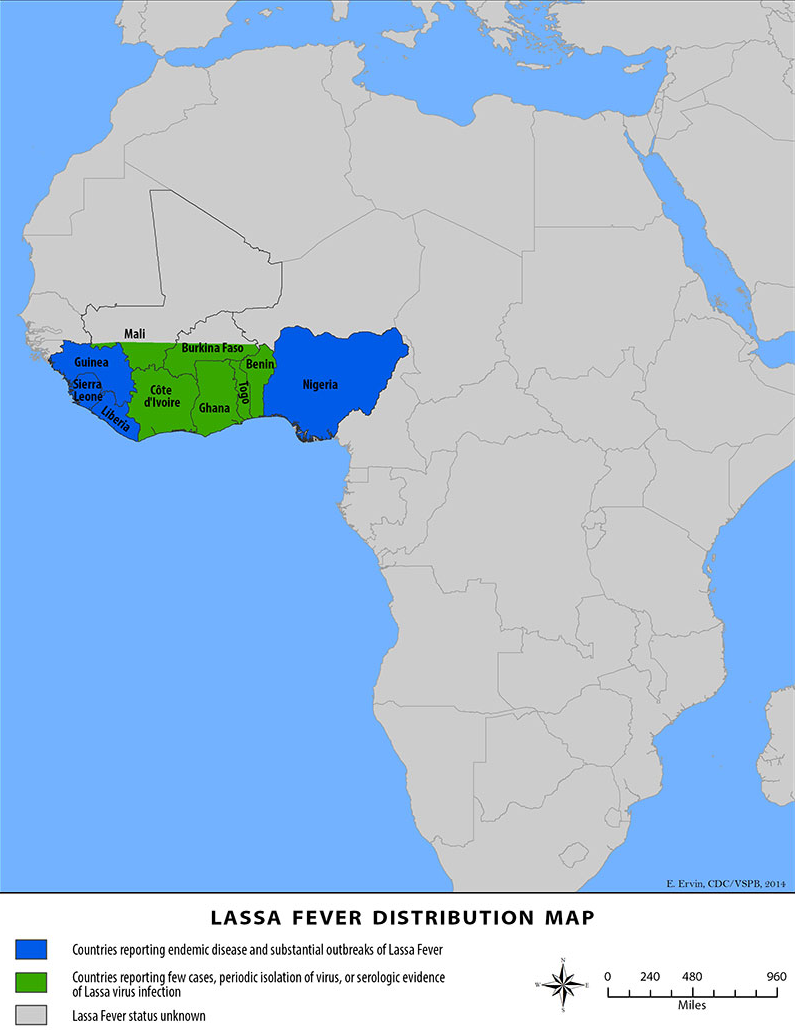Lassa fever epidemiology and demographics
|
Lassa fever Microchapters |
|
Diagnosis |
|---|
|
Treatment |
|
Case Studies |
|
Lassa fever epidemiology and demographics On the Web |
|
American Roentgen Ray Society Images of Lassa fever epidemiology and demographics |
|
Risk calculators and risk factors for Lassa fever epidemiology and demographics |
Editor-In-Chief: C. Michael Gibson, M.S., M.D. [2]
Synonyms and keywords: Lassa hemorrhagic fever; LHF
Overview
Epidemiology and Demographics
Prevalence
The dissemination of the infection can be assessed by prevalence of antibodies to the virus in populations of:
- Sierra Leone 8–52%
- Guinea 4–55%
- Nigeria approx. 21%
- The number of Lassa virus infections per year in West Africa is estimated at 100,000 to 300,000. Unfortunately, such estimates are crude, because surveillance for cases of the disease is not uniformly performed. In some areas of Sierra Leone and Liberia, it is known that 10%-16% of people admitted to hospitals have Lassa fever, which indicates the serious impact of the disease on the population of this region.

- Initially, several countries of West Africa were identified to be endemic for LASV, namely Sierra Leone[2][3], Guinea [37,38], Liberia [39,40,41], and Nigeria [42,43,44,45]. * However, a serological survey among patients admitted with a history of fever and missionaries that had experienced a febrile illness showed that LASV was also present in Ivory Coast, Mali, and Central African Republic [46].
- The notion that LASV was endemic in larger areas of West Africa was further supported by the results of investigation of an imported case of Lassa fever in Germany in 2000.
- During the incubation period, the index patient traveled through several countries, namely Ghana, Ivory Coast, and Burkina Faso, that were not considered to be endemic at that time [47]. Later, cases of Lassa fever have been reported from Burkina Faso, Ivory Coast, Ghana, Senegal, Gambia, and Mali [48,49].
- According to estimations, LASV is responsible for 100,000-300,000 infections and approximately 5,000 deaths annually [50]. However, the high degree of seroprevalence of LASV-specific antibodies in the general population residing in the endemic regions, although highly variable depending on the geographical location (from 1.8% to 55%) [4,37,43,51], indicates that most infections are mild or possibly even asymptomatic and do not result in hospitalization. This is also supported by the findings indicating a high incidence of LASV-specific seroconversion, from 5% to 20% of the nonimmune population per year [4]. Nosocomial outbreaks are associated with higher mortality rates ranging from 36% to 65% [40,42,52].
References
- ↑ "Center for Disease Control and Prevention (CDC)".
- ↑ McCormick JB, Webb PA, Krebs JW, Johnson KM, Smith ES (1987). "A prospective study of the epidemiology and ecology of Lassa fever". J Infect Dis. 155 (3): 437–44. PMID 3805771.
- ↑ Monath TP, Maher M, Casals J, Kissling RE, Cacciapuoti A (1974). "Lassa fever in the Eastern Province of Sierra Leone, 1970-1972. II. Clinical observations and virological studies on selected hospital cases". Am J Trop Med Hyg. 23 (6): 1140–9. PMID 4429183.